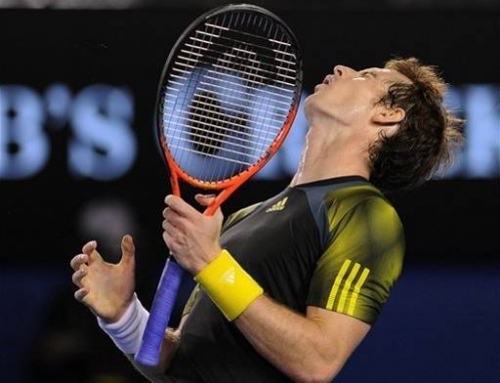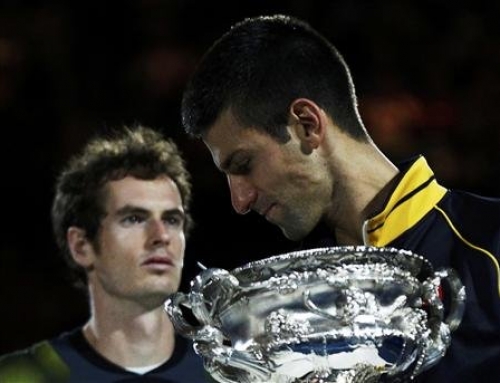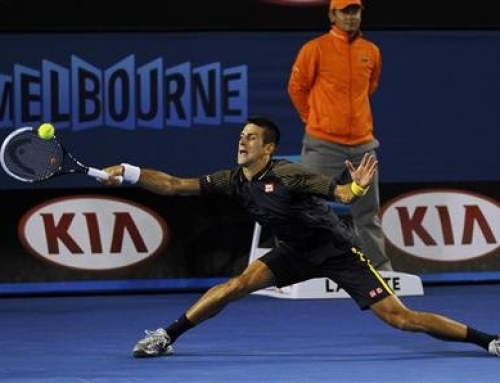They say the second week of any Slam is where the big boys come to play. Nowhere is this more literal than Day 7 of the Australian Open. Today, the tallest men left in the draw were all on tap.
First up, John Isner. John Isner stands 6’9″ with some claiming he’s taller than that. Isner came out of nowhere in 2007 as a wildcard to reach the final of Washington DC. One of his big victories was a win over Gael Monfils who he beat in the third round.
Andy Murray had never played John Isner. However, short of playing Nadal or Federer, Murray is perhaps the worst player for Isner to play. For all the criticism of passive play from Andy Murray, one thing the Scot excels at is returning serves. Murray generally does well against big servers. His record against Sam Querrey, an American similar in mold to Isner, and Ivo Karlovic, the big serving Croatian, is an impressive, 6-0. He has a 5-1 record over Juan Martin del Potro, with the one loss on clay, Murray’s weakest surface.
Murray is not exactly a small man either. At 6’3″, he’s in the neighborhood of heights of the really tall guys.
In the first set, Murray had a tough time reading the Isner serve, but was actually holding his own serve relatively straight-forward. He took the first set in a tiebreak. Starting in the second set, he was starting to read Isner’s serve better. He would break Isner once in the second set, and two more times in the third set. There were two points showing Murray’s defense.
One one point, Murray was driven to his right, and tossed up a lob. Isner hit an overhead down-the-line, but bounced it a bit short. Murray was moving to his left, took the ball above his shoulders, and then powered a down-the-line pass that Isner half-volleyed into the ground. In another point, Isner hit Murray out wide to his right. Murray returned that shot crosscourt. Isner took his chance and hit down the line and approached the net. Now, Murray had just been pushed wide of the right sideline, and now was returning all the way to his left, and at the back of the court, he hit a laser beam down the line, and passed Isner.
When commentators point to Murray’s defense, they are talking about defense in the days of superior offense. In the 1970s, players would rarely hit such big shots, so a master of defense, like Bjorn Borg, was a player that got the ball over the net one more time than you. When you can’t go for winners, you can learn to hit until the other player makes errors. Today, defense means getting back shots that look like winners or easy points, and Murray is the master of this skill.
Following this match, Rafael Nadal had his own problems. He would face the big serving Ivo Karlovic, the ace master from Croatia. Karlovic, it seems, was raised poor in Croatia, and while he played basketball, his attention eventually diverted to tennis, where he would spend hours practicing his big serve. Karlovic would later lament that due to his poor upbringing, he never had proper lessons, and his backhand has become a pro liability. Karlovic generally relies on a biting slice. Against other pros, this slice is often a changeup, a shot they don’t see that much. With Karlovic throwing in bombs, a player can lose rhythm, hitting few groundies, that Karlovic often does well holding his own serve even without a big bomb of a serve.
The first set saw Nadal having one game where he would see enough of Karlovic’s serve to break him. The conclusion after watching a set was that Karlovic was not quick enough and didn’t have a good enough backhand to win a set. Nadal could hit a few shots, and then eventually open the court enough to win the point or wait for Karlovic to try a topspin backhand that invariably find itself in the net.
In reality, Karlovic’s backhand would probably be good enough to play at the college level, but it is a deficiency that is so gaping at the pro level, that it’s amazing that he does as well as he does. He generally covers up his deficiencies by relying on the slice and coming to net.
Since Karlovic hits so many slices, one strategy he employs that’s pretty interesting is a drop shot approach shot. He actually hits this sneaky slice pretty well. It stays slow and barely clears the net. Karlovic used this strategy a couple of times and saw Nadal scrambling to net, and more often than not, won the game.
The second set win by Karlovic was entirely unpredictable. In a game that Karlovic won, Karlovic hit a point where he must have nicked the net cord three consecutive times before winning the point at the net. On the break point, Karlovic blooped a return, that landed on the left baseline mere feet from the net, almost an inside out forehand bloop drop shot, all unintentional. Nadal sprinted to his left and forward, and whipped the ball deep crosscourt, but a bit too deep and a bit too crosscourt. Game and set to Karlovic.
Despite the second set win, it didn’t look good for Karlovic. For one, Nadal was seeing Karlovic’s serve well enough about once a set to get a break, and even if he didn’t, his chances of winning a tiebreak was pretty good. And indeed, that’s exactly what happened. Karlovic pretty much lucked his way to the second set win. He would get no more break points on Nadal’s serve and Nadal would get the one break he needed in each of the third and fourth sets, to win: 6-4, 4-6, 6-4, 6-4.
The big match of the day had to be Marin Cilic playing Juan Martin del Potro. The two had only met in Slams (and still have only met in Slams). Both times, Cilic had won the first set, and had a break up in the 2nd, before nerves caught up, and del Potro’s superior play and toughness was too much.
But many had pointed to Cilic as someone that might break through, partly on these results and partly due to Andy Murray’s subpar exit at last year’s US Open to Cilic. But there’s another reason. Of all the tall guys–del Potro, Querrey, Isner, Karlovic–it is Cilic that doesn’t look like he’s that tall. Because he doesn’t have the huge game of any of these players, Cilic has relied more on his superior movement. For as big a game as del Potro has, he doesn’t move particularly well. Better than Isner and Querrey, but not as good as smaller men. Cilic moves more like a smaller men.
And in this match, he showed his mental resolve: 5-7, 6-4, 7-5, 5-7, 6-3. Apparently, Cilic had his chances to win the fourth set, but del Potro ended up winning. Cilic maintained his fight, and took an early 5-2 lead. del Potro held serve, then looked like he might break, but Cilic would have none of it, and would take the game and set, 6-3.
Due to yet another epic Henin win, beating yet another Belgian in Yanina Wickmayer, in three sets, the Andy Roddick-Fernando Gonzalez match hasn’t started as of 9:30 PM. The winner of this will play Marin Cilic.
There are four matches on slate tomorrow. Federer will play long-time rival, Lleyton Hewitt. Early on in their career, Federer lost a lot to Hewitt, unable to hit with him off the ground, until he developed a superior ground game. Still, Hewitt is a competitor. He played Federer tough at the US Open, and hopes to do the same to Federer. Federer generally doesn’t lose to players his age, and so expect a tight match, but a Federer win.
Nikolay Davydenko has yet to drop a set. He will play the hard hitting lefty, Fernando Verdasco, to whom he’s only ever lost once. Will Verdasco have answers to Davydenko’s style that robs most players of the time they need to hit? Davydenko is favored to win this matchup.
Novak Djokovic is having a pretty sweet draw. He’s yet to face a really tough opponent. Although he will face a talented Pole in Lukacz Kubot, Kubot is the big underdog. The two have only played once in a tournament that Djokovic runs, Belgrade. Djokovic won 6-3, 7-6. One would imagine Djokovic, after his clinical win over Istomin, would be feeling pretty good about his game and would take it to Kubot.
Finally, 10th seeded Jo-Wilfried Tsonga will play Spaniard, Nicolas Almagro. The two have never played each other. Tsonga should be favored.






![[Aussie Open Final] Can Andy Murray beat Novak Djokovic?](https://www.essentialtennis.com/wp-content/uploads/2013/01/20130126andy-500x383.jpg)
![[Day 13, Aussie Open] Bryan brothers win 13th Slam with Aussie doubles title, Kyrgios wins boys title](https://www.essentialtennis.com/wp-content/uploads/2013/01/20130125bryan-500x383.jpg)